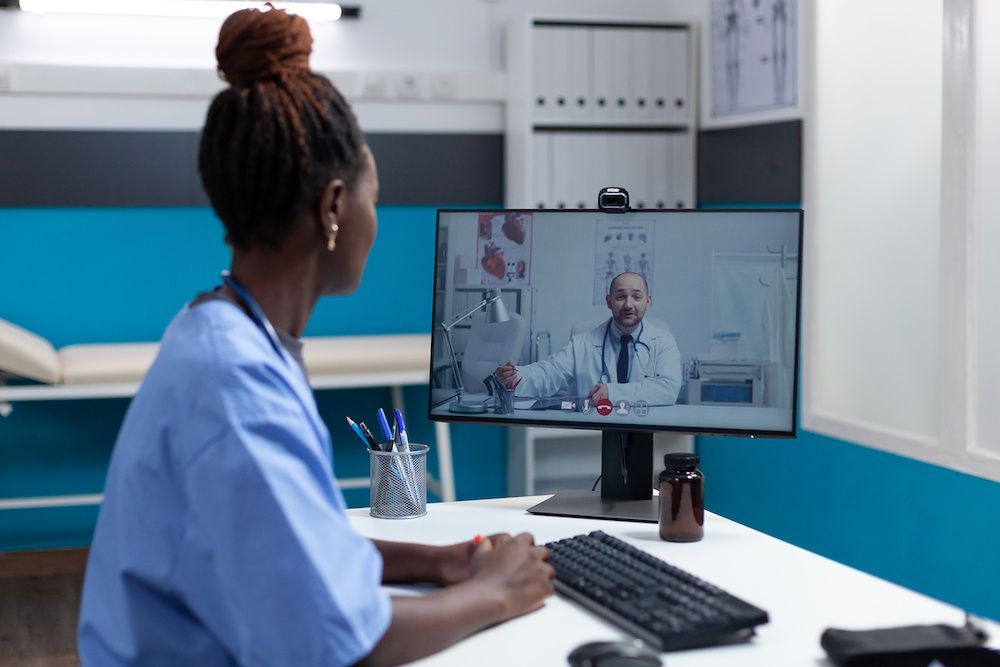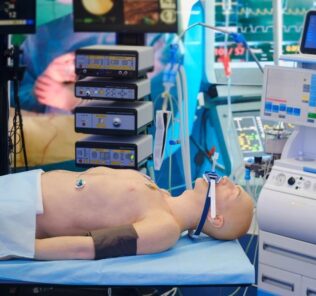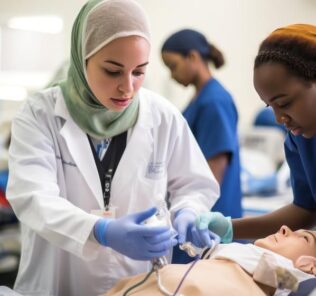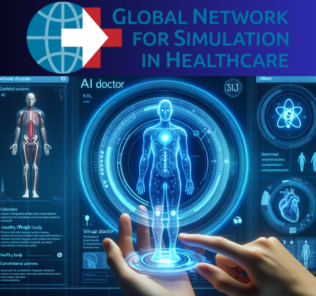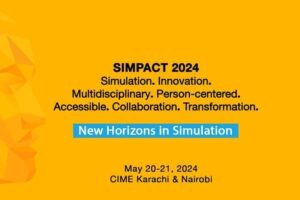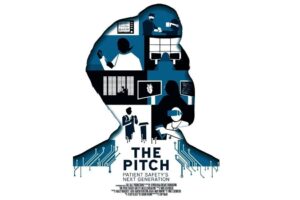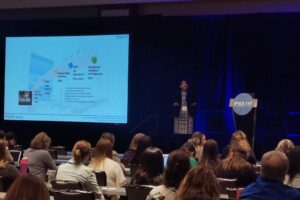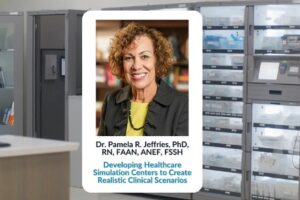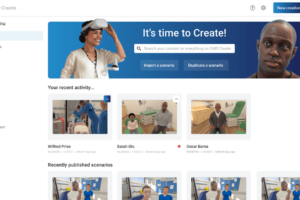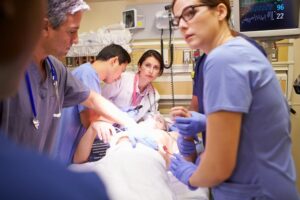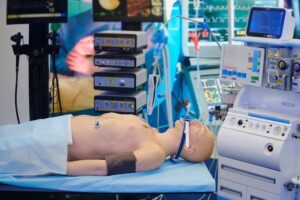Healthcare Simulation Webinars Focused on Staff and Simulationist Professional Development
Professional development is critical for clinical simulation programs and their ability to conduct high-quality simulations for learners to achieve learning outcomes. Best practices in healthcare simulation and education state appropriate education, training, jobs, and development of the facilitators must be followed to achieve the best outcomes. Beyond the article resources on staff development summarized on the medical simulation jobs page, HealthySimulation.com presents a number of staff and simulationists presentations to help fulfill the HealthySimulation.com CE/CME LEARN webinar platform mission to provide informative and relevant healthcare simulation webinars each month. Staff and simulationist development is the focus for this article recapping webinars on the HealthySimulation.com CE/CME LEARN Platform:
Pilot Study: Standardizing Simulation Operations Specialist Training with Frameworks (Erica Hinojosa, MSHS, CHSOS-A): Healthcare Simulation Operations Specialists currently face a significant deficiency in training standards. Research suggests that Simulation Operations Specialists roles are clearly defined but there is limited research on how to train Simulation Operations Specialists once in the role. This pilot study aims to determine how the Learn, See, Practice, Prove, Do, Maintain Framework is utilized with procedural task trainers to train Simulation Operations Specialists. Specifically, this study will evaluate the Learn, See, Practice, Prove, Do, Maintain Framework for future training, efficiency, proficiency, and competency.
The results suggested that the Learn, See, Practice, Prove, Do, Maintain Framework is a valid framework to utilize to train current and future Simulation Operations Specialists. The results reinforce the importance of training Simulation Operations Specialist.
Sponsored Content:
Learning objectives include:
- Implementing the Learn, See, Practice, Prove, Do, Maintain Framework (LSPPDM) Framework for Simulation Operations Specialist (Sim Ops)Training.
- Analyzing the results that have been provided from utilizing the LSPPDM Framework.
- Recognize the challenges and limitations in the LSPPDM Framework
A Sim Tech’s Journey in the NHS at DASH Northumbria (John Stratford, RSciTech):
The presenter will share his role in championing innovative simulation technologies within the program to clinical educators and administrators alike, specifically around Mixed Reality (XR) training technologies. He will share how he has been able to increase utilization of simulation technologies while simultaneously reducing clinical educator stress. Finally, the presenter will discuss his vision for the future of medical simulation. Learning objectives:
- Share the experiences of working as a clinical simulation technologist in the NHS.
- Showcase innovative simulation technologies, including XR technologies, which have improved outcomes at the DASH simulation center.
- Consider the future of simulation-based training and the technologies of the future.
Badging for Clinical Simulation Operations: What? Why? How? (Suzan Kardong-Edgren PhD, RN, ANEF, CHSE, FSSH, FAAN): Badges or microcredentials are currently being used extensively in businesses outside of healthcare to document newly gained skills. Simulation is just beginning to dip its collective toe in the badging waters. Badges might appeal to simulationists and sim operations professionals because the role often does not fit into the predefined boxes created by current institutions of higher learning. Badging could prepare these non-traditional learners and those without the time or funds to attend traditional academic programs to demonstrate continued skill acquisition and competency in a new manner gaining popularity across the world. This presentation will discuss what badges are, why they are being used in the place of more traditional education, how they are earned, and what sources of badging exist for simulationists now. Learning objectives:
Sponsored Content:
- Learners will be able to describe badging.
- Learners will be able to explain why badging is growing as an alternative to traditional education.
- Learners will be able to name two potential sources for badging in simulation.
Professional Development for Healthcare Simulation Operations Specialists (Tom Dongilli, AT, CHSOS-A, FSSH): While all Clinical Simulation Operations Specialist roles may vary by institution, the fundamental responsibilities remain the same, and the skills needed for SOSs to develop can be taught and developed through standardized training throughout the industry. This webinar will review what the key tasks associated with the daily operations and maintenance of a simulation center are, and what kind of training can hone an SOS’s skills. The webinar will provide an overview of WISER’s TechSim course as a tool for that development. TechSim is directly aligned with the Society for Simulation in Healthcare’s Certified Healthcare Simulation Operations Specialist (CHSOS) Blueprint and is eligible for continuing education credits applicable toward re-certification. Participants will get access to the free preview version of the course, as well as a peek inside the broader TechSim curriculum. Learning objectives:
- Gain better understanding of core Medical Simulation Technician training needs.
- How the Tech Sim training maps to the CHSOS blueprint [Prof dev CHSOS->crs->job].
- Present a general understanding of WISER’s full Tech Sim course offerings.
Building Better Clinical Simulation Experiences Through Collaborative Cross Training (Beverly Price, BSN, RN, CHSOS, Melissa Malone MSN, RN, GERO-BC, NPD-BC): Within the healthcare simulation practice, operations and education are intertwined and simply cannot excel independent of one another. Simply put, collaboration between the two roles is vital. An effective way to foster that collaborative mindset is to train both clinical educators and operations specialists on the basic functionality of high-fidelity manikins. A broader understanding of the human patient simulator functionality and operations allows an educator to increase realism and fully utilize the high-fidelity manikins, ultimately helping to meet clinical simulation learning objectives. A discussion of instructional objectives with the operations specialist assists in overall improvement in collaboration and development of simulation activities. The presenters will discuss the creation and implementation of plans for departmental cross training. Learning objectives:
- Identify one educator within your department that could participate in training in the role of operations
- Create a “next steps” plan for cross training within the department.
- Identify key stakeholders in implementing plan to train educators in the operations of simulation.
CSDS: A Guide to Scalable and Sustainable Simulation Programs (Luke Wainwright, RN): The Clinical Skills Development Service (CSDS) is one of the largest education and training organisations in the world. Part of the Metro North Hospital and Health Service, Queensland Health, Australia, it supports simulation based education and training to over 127 sites across Queensland. The Service maintains a fleet of almost 3000 simulators including over 200 full body manikins provided at no cost to the sites it supports. It also hosts and delivers over 80 courses, both online and face to face, at its simulation centre in Brisbane and across the state. Learning Objectives:
- Recognize how the integration of human centered design principles lead to an effective clinical simulation program.
- Support the delivery of a scalable, sustainable simulation education model which has been proven effective in the training healthcare professionals.
- Demonstrate the coordination and management of simulator equipment needed to continue scaled expansion goals.
Designing Your Nursing Simulation Center for Current and Projected Needs (Anne Costello, MSN, RN, CHSE): As many nursing educational programs look to increase enrollment, the need for increased physical space for clinical skills and medical simulation training is often a major consideration. The program’s simulation director or coordinator are often the one approached with the question, “If we were to increase enrollment, what would you need?” While exciting, this ask can also be incredibly overwhelming to those new to simulation center design and planning. This webinar will provide an overview of considerations for those who are anticipating a renovation or build of a new nursing simulation center. Highlights will include recommended processes for conceptualizing a medical simulation center design to fit your program’s needs, who to include in your planning, questions to ask your architecture team, considerations for designing flexible and adaptable spaces, and lessons learned in our design and planning phase. Learning Objectives:
- Discuss processes used to conceptualize simulation center design.
- Identify at least two stakeholders needed to engage in simulation center design.
- Articulate at least two examples of flexible spaces in simulation design.
Digital Wellness for Techs, Educators, and Participants: Keeping Online Simulations Inclusive (Arielle Cartmill, CHSOS): Technology is innovating at lightning speed and sending us places we could only ever dream. However, with the expansion of digital consumption and use within the workspace, productivity and well-being have become challenging for individuals and teams. In acknowledging the stress and triggers that manifest within zoom fatigue, electronic and digital accessibility, time constraints, lack of education around these electronics, and the feeling of constantly having to be “on” – it is my goal to empower others with support, validation, and steps to manage these challenges. The purpose of this webinar is to focus on understanding and gaining knowledge about the implications and impacts of increasing technology use including digital communication during times of COVID-19; translating research into accessible knowledge for teams to use as best practices for embodying mindfulness and wellness while using technology within team dynamics; and empowering teams to implement wellbeing practices into their daily functions in order to boost morale, health, and team cohesiveness while respecting people’s individual needs and autonomy. Learning Objectives:
- Identify gaps between digital fatigue and wellbeing.
- Fill the gaps in personal and professional wellbeing with best practices for wellness.
- Influence others to apply best practices personally and professionally within their team.
More About HealthySimulation.com Webinars
HealthySimulation.com’s streamlined clinical simulation webinar platform launched in March of 2021, and has since featured some of the most consistent CE/CME healthcare simulation webinar content in the world! These webinars offer live and on-demand content from some of the world’s leading healthcare simulation experts, covering everything necessary to successfully start, develop, or expand a clinical simulation program. Topics range from safe medication administration to moulage and manikin functions. Many HealthySimulation.com webinar presentations are recorded and viewable from anywhere at any time. Learn more about signing up your department today!
Subscribe to the HealthySimulation.com LEARN CE/CME Platform!
Lance Baily, BA, EMT-B, is the Founder & CEO of HealthySimulation.com, which he started while serving as the Director of the Nevada System of Higher Education’s Clinical Simulation Center of Las Vegas back in 2010. Lance is also the Founder and acting Advisor to the Board of SimGHOSTS.org, the world’s only non-profit organization dedicated to supporting professionals operating healthcare simulation technologies. His co-edited Book: “Comprehensive Healthcare Simulation: Operations, Technology, and Innovative Practice” is cited as a key source for professional certification in the industry. Lance’s background also includes serving as a Simulation Technology Specialist for the LA Community College District, EMS fire fighting, Hollywood movie production, rescue diving, and global travel. He and his wife Abigail Baily, PhD live in Las Vegas, Nevada with their two amazing daughters.
Sponsored Content:



